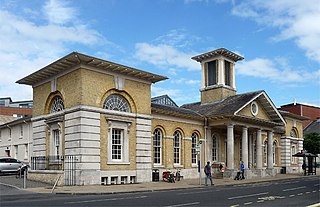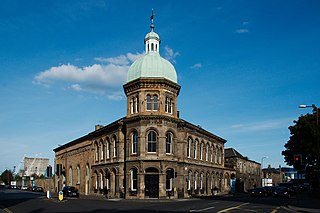
Manningtree is a town and civil parish in the Tendring district of Essex, England, which lies on the River Stour. It is part of the Suffolk Coast and is an Area of Natural Beauty.

A corn exchange is a building where merchants trade grains. The word "corn" in British English denotes all cereal grains, such as wheat and barley; in the United States these buildings were called grain exchange. Such trade was common in towns and cities across England until the 19th century, but as the trade became centralised in the 20th century many such buildings were used for other purposes. Several have since become historical landmarks.

The Corn Exchange is an events and concert venue located on St Paul's Square in the Castle area of Bedford, Bedfordshire, England. The structure, which was commissioned as a corn exchange, is a Grade II listed building.

The Edinburgh Corn Exchange is an events and concert venue located in New Market Road in Edinburgh, Scotland. The structure, which was commissioned as a corn exchange, is a Category B listed building.

Corn exchanges are distinct buildings which were originally created as a venue for corn merchants to meet and arrange pricing with farmers for the sale of wheat, barley, and other corn crops. The word "corn" in British English denotes all cereal grains, such as wheat and barley. With the repeal of the Corn Laws in 1846, a large number of corn exchanges were built in England, particularly in the corn-growing areas of Eastern England.

The Corn Exchange is a commercial building in King Street, Ipswich, Suffolk, England. The structure, which is currently used as a public events venue, is Grade II listed building.

The Corn Exchange is a commercial building in the Market Place in Saffron Walden, Essex, England. The structure, which is currently used as a library, is a Grade II listed building.

The Corn Exchange, also known as The Arc, is a commercial building in Jewry Street in Winchester, Hampshire, England. The structure, which is currently used as a cultural hub, is a Grade II* listed building.

The Albert Hall is a commercial building in the High Street, Colchester, Essex, England. The structure, which was commissioned as a corn exchange and is now used as a bank, is a Grade II listed building.

The Corn Exchange is a commercial building in Constitution Street, Leith, Scotland. The structure, which accommodates studio space and an exhibition gallery, is a Category A listed building.

The Corn Exchange is a commercial building in Queen Street, Market Rasen, Lincolnshire, England. The structure, which is used as the offices of a firm of charted surveyors, is a Grade II listed building.

The Corn Exchange is a commercial building in Castle Gate, Newark-on-Trent, Nottinghamshire, England. The structure, which is currently used as a nightclub, is a Grade II listed building.

The Corn Exchange is a commercial building in Market Street, Witney, Oxfordshire, England. The structure, which is used as a public events venue, is a Grade II listed building.

The Corn Exchange is a commercial building in the Market Place, Fakenham, Norfolk, England. The structure, which is currently used as a cinema, is a Grade II listed building.

The Corn Exchange is a commercial building in the Corn Market, Romsey, Hampshire, England. The structure, which is has been used extensively as a bank branch, is a Grade II* listed building.

The Corn Exchange is a commercial building in Thurland Street, Nottingham, Nottinghamshire, England. The structure, which is now used as an events venue, is a Grade II listed building.

The Corn Exchange is a commercial building in Angel Street, Worcester, Worcestershire, England. The structure, which is currently vacant, is a Grade II listed building.

The Corn Hall is a commercial building in the Market Place, Swaffham, Norfolk, England. The structure, which is used as offices and as a coffee house, is a Grade II listed building.

The Corn Exchange is a commercial building in Sandgate, Berwick-upon-Tweed, Northumberland, England. The structure, which is now used as an apartment block, is a Grade II listed building.

The Corn Exchange, also known as the Women's Institute Hall, is a commercial building in West Street in Rochford, Essex, England. The structure, which is now used by the local branch of the Women's Institute, is a Grade II listed building.





















